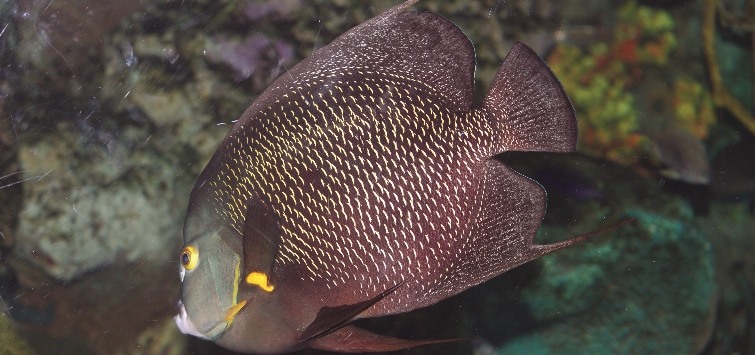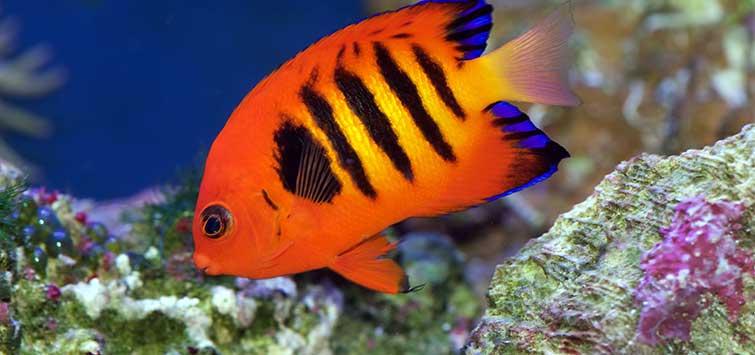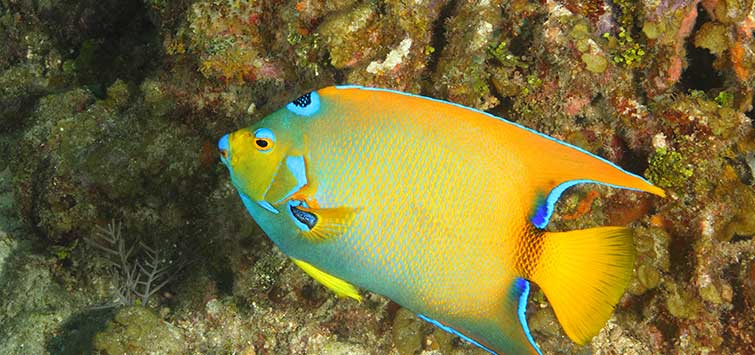Keeping Saltwater Angelfish from the Caribbean
Author: Mark Denaro
Since the early days of the marine aquarium hobby in America, saltwater angelfishes from the Caribbean have been much desired and sought after by aquarists. Of course, back then there weren’t as many to choose from, but even now, with thousands of different types of aquarium fish being shipped here from around the world, the appeal of Caribbean angels hasn’t waned.
The rise in popularity of reef aquariums, however, means that not everyone can keep an angel in their tanks. Reefkeepers can only keep one species, the pygmy angelfish, the only angel that is truly suitable for a reef tank. The rest, however, make excellent additions to a fish-only or fish-only-with-live-rock (FOWLR) system.Pygmy Angel (Centropyge argi)
The cherubfish or pygmy angelfish (Centropyge argi) is the smallest angel and a grazer by nature, feeding primarily on algae and plants. I’ve never seen this species eat coral in a reef aquarium, and I’ve cared for at least 50 of them in customers’ tanks during the years I was doing aquarium maintenance. That said, I know others who’ve had the opposite result, so it is important that you observe this species carefully to ensure that it is not feeding on any of your prized corals.
Growing to a maximum of just over 3 inches (7.5 cm), C. argi is suited to fairly small tanks, anything but the smallest of nano tanks. They tend to get along well with each other and can be kept in a group, as long as they are added at the same time and the tank is large enough to accommodate them.
All of these fish start out as females; some will eventually become males, as determined by the population dynamics and their position in the social hierarchy. Because of this, if you want them to spawn, your group should include one large male and at least two smaller individuals, who should be females.
The first time I kept them in a group was more than three decades ago. I had one larger fish and two smaller fish, and they shared the tank with a pair of royal grammas, some Florida Keys live rock, and an assortment of invertebrates. While I never saw the royal grammas spawn, I was fortunate enough to see the pygmy angelfish spawn on a number of occasions. Spawning would always take place in the evenings and would include the male pursuing the female, followed by a bit of ritual display and then a rise toward the surface, during which they would simultaneously emit eggs and milt. Of course, this was long enough ago that the tank was filtered with an undergravel filter, and I never made any effort to collect the eggs or attempt to rear them at the time. With today’s improved keeping methods and better quality foods, though, spawning this species should be fairly straightforward.
Now, onto the non-reef-friendly species best suited to a fish-only or FOWLR system.
Rock Beauty (Holacanthus tricolor)
The rock beauty (Holacanthus tricolor) is the most difficult species to maintain from this group due to its diet. In the old days, it would seem to do well for a while and then just turn up dead one day. We always presumed that this had to do with diet.
H. tricolor feeds primarily on sponges in the wild, with tunicates also constituting a fair part of its diet. In addition, it feeds on zoanthids, the hard coral Montastraea cavernosa, and other benthic growth. The advent of frozen foods containing sponges has made a significant contribution to the longevity of this species in the aquarium, and these should be the main food offered. With this change, probably along with improved water quality and better understanding of the needs of marine fishes and invertebrates, you should have better luck with them than aquarists did in the past.
Despite the species name tricolor, the fish has five colors when adult, though juveniles only sport three colors. Juveniles are bright yellow with a small black dot edged in blue along the dorsal in front of the caudal peduncle. Its most attractive feature, though, may be the eyes, which while not completely blue, have blue along the top and bottom. As the fish grows, so does the black body spot, and its blue edge eventually disappears. The black spot will ultimately cover approximately 70 percent of the fish’s body.
The rest of the body is yellow, including the fins. The dorsal and anal fins are edged in red with a narrow margin of green just inside of the red. While capable of reaching 14 inches (36 cm) in length, this species will not reach that size in a home aquarium; the largest individuals I’ve ever seen have been around 8 inches (20 cm). That is still a sizable fish, however, and a spacious tank is needed for a rock beauty.
Blue and Queen Angels
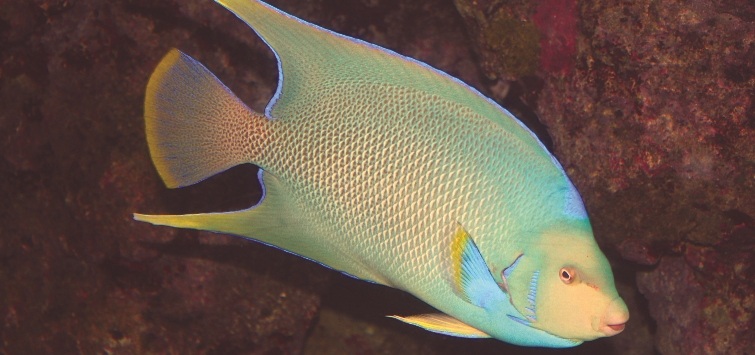
Blue angels (H. bermudensis) and queen angels (H. ciliaris) are similarly patterned in both the juvenile and adult stages. The juvenile queen has a bit more orange in its coloration and a bit less of a curve in its vertical bars. Adult queens are more yellow, even phasing into a greenish color in specimens from Brazil. Additionally, adult queen angels sport a crown on the nape.
Adult blue angels, on the other hand, tend to be more whitish, though they can also display quite a bit of yellow. Making distinguishing them even more difficult is the existence of hybrids between the two, which were at one time described as a separate species and are commonly known as Townsend’s angels. The hybrid coloration can be anywhere in the spectrum of colors between the two parents.
The two species are similar in every respect, including their size, potentially to 18 inches (46 cm) in the wild (though somewhat less in captivity), and their temperament. If you see a specimen that you like that is in good condition, buy it regardless of the species. I’ve never seen one of these fish that I would consider unattractive. My preference runs a bit to the queen because I like the crown and find the overall pattern to be more colorful, but I really like them both.
Both of these angels feed on sponges, tunicates, and a variety of benthic organisms, and they should be offered foods with a significant amount of sponge on a regular basis. They are extremely hardy and long-lived, and best suited for large tanks. While juveniles can be maintained in smaller tanks, a long-term plan should be in place that takes into account their large maximum size. I should note that I’ve seen a few queen angels kept in reef aquariums where they never bothered the corals, and where they’ve grown from small juveniles to nearly fully grown adults. If you want to try to add one to your reef, go ahead, but observe it closely and be prepared to remove it if it starts to eat your corals or other invertebrates.
French and Black Angelfish
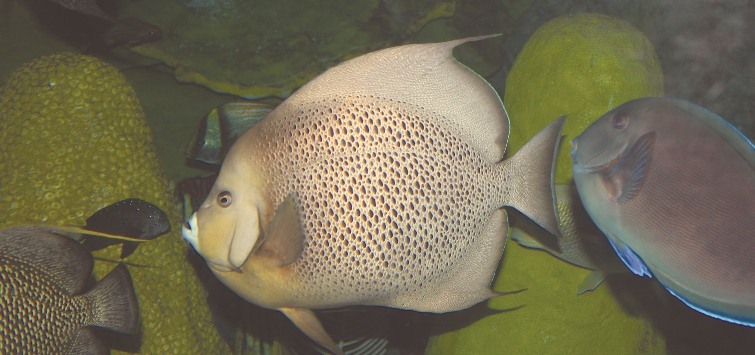
The coloration of French and black angelfishes is similar while the two are in juvenile coloration, but very different in adults. As juveniles, both species are black with curved yellow lines on the body. The French angel (Pomacanthus paru) also features a caudal that is completely edged in yellow. The black angel (P. arcuatus) is also referred to as the gray angel. Its juvenile looks the same as the French with the exception that the rear edge of the caudal fin is fringed in clear rather than in yellow.
Both species have the potential to grow to 24 inches (60 cm) in length. Because they are more or less disk-shaped, being about as tall as they are long, this means they are a rather impressive size. I have seen a couple of French angels reach fully grown size, but I’ve never seen a black angel over about 15 inches (38 cm) in the aquarium. Their potential size means that the aquarist’s long-term plan should include a very large tank, at least 300 gallons (1,100 liters). Even if they don’t reach full size, a big tank is a necessity. These are particularly long-lived fishes, and it’s not at all out of the realm of possibility that the hobbyist will have them in excess of 20 years, so the expenditure for the tank seems more readily justifiable.
Adult black angels are an attractive fish, but they really can’t be described as colorful, as they are mostly gray. The extensions to the dorsal and anal fins add greatly to their appearance, and they truly are graceful and elegant. Their price is significantly lower than that of a French angel, and this will make the choice between the two for many people relatively straightforward. If you’re looking for color, though, the French angel must be your choice. Adults are a darker gray, and the rear edge of most of the scales is gold, which combines with the extensions on the dorsal and anal fin to make them one of the world’s most beautiful saltwater angelfish.
I’ve kept juveniles of both black and French angels in reef aquariums. Most of the time, they’ve done quite well and not bothered the corals. This was always intended to be a short-term thing, as the fish would outgrow the tanks. Consequently, I’ve always moved them on to larger tanks as they grew and don’t have specific experience with attempting to keep adults in a reef. If you want to try it, I’d definitely suggest starting with a juvenile and having a backup plan in case you need to remove it from the tank. Bear in mind that their diet in the wild, while consisting primarily of sponge, also includes tunicates, zoanthids, gorgonians, and the like. Be sure to feed frozen food containing sponge on a regular basis.
Black and French angels were the first saltwater angelfish to be reared in captivity and offered for sale in the trade. Martin Moe Jr. first cultured them in the late 1970s. I purchased some from him and sold them in my first aquarium shop in the mid-1980s. He also produced a hybrid between the two that he called the ARC angel, named after his company Aqualife Research Corporation. Unfortunately, I don’t know of anyone working with these species today, so captive-bred juveniles are not currently available.
Better Angel-Keeping
The saltwater angelfish of the Caribbean have something to offer almost every marine aquarist, so consider one for your current or next tank. If you’re looking for a challenge, I would suggest a trying to breed and raise up C. argi, which should be achievable for just about any marine aquarist with some experience under their belt. The trickiest part will be in raising the fry, but with the information available about raising numerous species of Centropyge, this is something many should be able to accomplish.Good luck and happy angel-keeping!

.png?h=595&iar=0&w=2781&hash=5FD5E69473BCC22199FBFA2FB71B6033)
